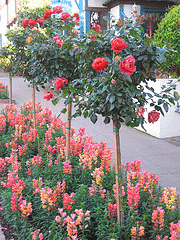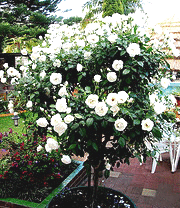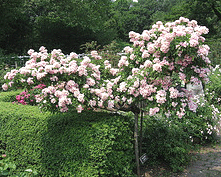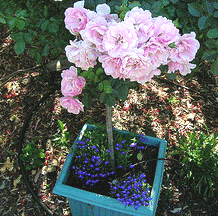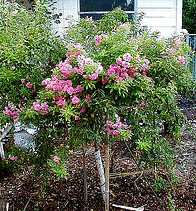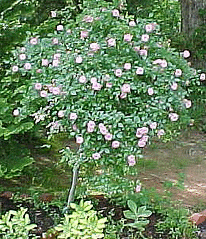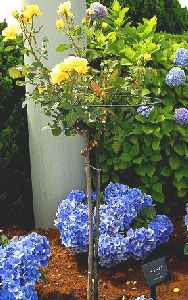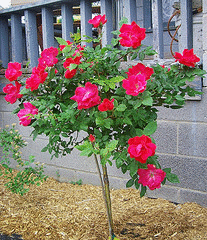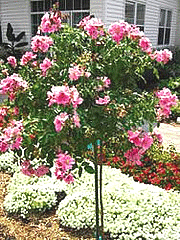Tree roses, more properly known as rose standards, are an elegant addition to any garden or landscape.
Rose standards are not a class of rose, but rather a way of growing roses. A rose bush, creeping, or climbing rose is grafted to a trunk giving the appearance of a tree. Often the trunk is further grafted to hardy rootstock. The grafts are very susceptible to cold damage. Rose standards require a little special care in all climates, but in zones 6 and north, damaging winters require creative protection measures. Midwest and Northern gardeners were very excited about the introduction of the ‘Polar Joy’ hardy tree rose. This is an “own root”, winter hardy to zone 4 tree rose, not a grafted standard. More on that later.
Before deciding whether to grow rose standards, take a moment to understand the pros and cons. Make sure you are able to keep up with the necessary care for your region before investing the time and money. You will absolutely be rewarded with gorgeous garden accents, and wonderful fragrance as a bonus!
Benefits:
Adds vertical interest to a garden, landscape
Adds elegance to an entry garden or foundation planting
Less susceptible to insects and disease since the bush is elevated
Easy access for the gardener for pruning and spraying
Rose standards are stunning, elegant, and attract attention
Challenges:
May require more water than bush roses
Must be staked
The standard, or trunk, is susceptible to sunscald
The canes, being elevated, are more exposed to winds and susceptible to dessication
Requires rather elaborate winter protection methods in zones 4 and 5
Really, that doesn’t sound so bad does it? So are you ready? This is what you need to know to get started:
Best roses for standards
Literally any rose can be grafted to a standard to create a tree. Traditional tea roses, grandiflora and floribunda roses, and shrub roses create a more formal structure with a rounded head. Climbing roses grafted to a standard create a waterfall effect. Creeping groundcover roses create an elegant weeping effect.
One important quality is that the rose be everblooming. A rose standard is elevated for all to see, all the time, and you would like it to be in bloom as much as possible. But it is also important that the rose create a pleasing form naturally, without arduous pruning. Here are a few that do very well as a standard:
'Iceberg'
‘Iceberg’ is an all time favorite for standards. Blooming occurs in two main flushes spring and fall, with a few blooms throughout the season. ‘Iceberg’ creates very well-shaped, full crown and emits a lovely spicy scent.
‘Ballerina’
‘Ballerina’ is a fantastic weeping standard with single open blooms on arching stems. It blooms prolifically
‘Bonica’
‘Bonica’ is from the Meilland family and is a reliable repeat bloomer. The crown is slightly weeping, with large bloom clusters held on arching branches.
China Doll’
‘China Doll’ is a naturally weeping polyantha that blooms profusely in clusters on long stems.
‘Fairy Rose’
‘Fairy Rose’ is also a naturally weeping polyantha with tiny continuous blooms.
‘Freisia’
‘Freisia’ is a bright yellow floribunda that is fabulous elevated over blues, so striking! It is also known as ‘Sunsprite’. This floriferous standard has a wonderful perfume.
‘Knockout’
‘Knockout’ makes a perfect rose standard, any color or variety. The blooms are non-stop and abundant with vivid colored petals.
‘Arthur Bell’
‘Arthur Bell’ is a popular floribunda and has a wonderful scent and large well formed blooms. Pink and yellow buds open to golden yellow blooms early in the season, turning creamy yellow as the blooms mature. Blooming begins early and is a good repeater.
'Polar Joy'
Polar Joy: A tree rose hardy enough for zone 4, finally! This diminutive ornamental, 4 to 8 feet, is covered with continuous clusters of pink blooms. Rose trees are often a bit of work in the North and Midwest, ‘Polar Joy’ is requires the least care, as easy as any tree or shrub. It was introduced in 2007 by Bailey Nurseries in Minnesota, experts in winter hardy plants. Do protect this little darling, minimal to moderate just in case, and be sure to get “own root”, if it is truly a ‘Polar Joy’ it WILL be own root. Most rose trees are grafted to the stem of unknown variety, ‘Polar Joy’ generally is not grafted. Gardeners who have grown ‘Polar Joy’ in Minnesota’s zone 4 rave about its’ hardiness with no protection whatsoever. A stunning accent to a front entry or patio, or underplanted with groundcover roses or perennials. Does beautifully in a large container. Matures to a 5-8 foot tree, may be pruned to control size.
Check your local garden centers, they like to carry rose standards that do well in the region. Or browse on line sellers and catalogs for more selection. Just make sure you research to see how the rose does in your specific climate.
Where do you want to use a tree rose?
Rose standards are ideal for a variety of situations:
Adding height and structure to a garden
As an accent or specimen plant
Adding elegance and fragrance to an entry garden
Potted patio plantings
Different heights and rose sizes are available to suit your purpose. Miniature roses are generally grafted to one or two foot trunks, which are perfect for patio trees in containers. Floribundas, grandifloras and hybrid tea roses are grafted to trunks about 3 or 4 feet tall. At that height, a rose standard can be used just about anywhere. The crown is perfectly elevated above a perennial garden, or is at about eye level for an entry planting or lining a path or drive. Larger spreading or climbing roses that create a weeping effect are sometimes grafted to a six foot trunk for a grand effect.
Buying Your Tree Rose
It is important to buy from a reputable retailer when purchasing roses. And be willing to pay what is necessary for a healthy grade 1 or 1 1/2 rose, you can not nuture an inferior rose to a grade 1. Many gardeners prefer to purchase potted roses. They can be purchases and replanted/transplanted just about any time of year if they are potted. Bare root roses should only be sold in while dormant in very early spring, prior to the start of the growing season. They must be planted quickly, or temporarily stored in a cold dark place.
When shopping for your tree rose, remember that the trunk is not only very exposed to sun and wind, but it needs to support the full weight of the rose and be strong enough not to snap in the wind. You will need to stake your standard to prevent breaking, but do try to select a sturdy trunk to start with. Look for the thickest trunk possible, at least 3/4” to 1” in diameter if not more. Closely examine the entire trunk for any cracks, holes, breaks or other damage. A trunk weakened by any damage can more easily snap if a strong wind buffets the crown.
Examine the canes in the crown for similar damage or weakness. Try to get four to six strong healthy canes. An even and rounded shape is a plus, but if the canes are strong and healthy future pruning can shape it up. If you are buying bare root, you can also inspect the roots to make sure they are not damaged.
Plan ahead for how you will get your tree rose home. First, never never pick it up by the trunk! Always pick up the pot. Chances are, you will not be able to transport the tree upright unless you have a pick up truck. In a pick up, make sure the pot is wedged up against the cab so it does not tip over and break or roll around in the truck bed. And cover the entire tree so it is protected from the wind. You may be able to adjust seats and transport your tree rose in the passenger side with the pot on the floor and the tree leaned into the seat. You still want to make sure it is secured enough that it doesn’t roll around. And the container will be slightly tipped, so fill the pot with newspaper to the top and secure with a secured old sheet or blanket, or just duct tape all across the top of the newspaper to prevent the soil from winding up all over your car. The nursery I frequent usually does something similar for me, but I always go prepared to take care of it myself. If the soil is secured well enough in the container, I can lay it down completely flat in the back of my vehicle. Again, make sure it is wedged in so it does not roll around and damage the plant. It is also a good idea to wrap the crown in a sheet or burlap to prevent any jostling from breaking canes.
